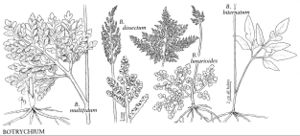Difference between revisions of "Botrychium dissectum"
Anleit. Kenntn. Gew. 3: 172. 1804.
FNA>Volume Importer |
FNA>Volume Importer |
||
| Line 20: | Line 20: | ||
}}<!-- | }}<!-- | ||
| − | --><span class="statement" id="st- | + | --><span class="statement" id="st-undefined" data-properties=""><b>Trophophore </b>stalk 3–15 cm, 1.5–2.5 times length of trophophore rachis; blade shiny green, often bronze in winter, plane to convex, 3–4-pinnate, to 20 × 30cm, leathery. <b>Pinnae</b> to 10 pairs, approximate to remote, slightly ascending, distance between 1st and 2d pinnae not or slightly more than between 2d and 3d pairs, undivided except in proximal 2/3–3/4. <b>Pinnules</b> usually obliquely angular–trowel-shaped to widely trowel-shaped to obliquely round-lanceolate to ovate and pointed, margins denticulate to lacerate to coarsely cut halfway or wholly into linear-divergent segments in some populations, venation pinnate. <b>Sporophores</b> 2–3-pinnate, 1.5–2.5 times length of trophophore. <b>2n</b> =90.</span><!-- |
-->{{Treatment/Body | -->{{Treatment/Body | ||
| + | |phenology=Leaves green over winter, new leaves appearing in late spring. | ||
|habitat=In variety of habitats, open grassy areas to deep forest | |habitat=In variety of habitats, open grassy areas to deep forest | ||
|elevation=0–1500 m | |elevation=0–1500 m | ||
| Line 42: | Line 43: | ||
|basionyms=Botrychium obliquum | |basionyms=Botrychium obliquum | ||
|family=Ophioglossaceae | |family=Ophioglossaceae | ||
| + | |phenology=Leaves green over winter, new leaves appearing in late spring. | ||
|habitat=In variety of habitats, open grassy areas to deep forest | |habitat=In variety of habitats, open grassy areas to deep forest | ||
|elevation=0–1500 m | |elevation=0–1500 m | ||
| Line 49: | Line 51: | ||
|publication year=1804 | |publication year=1804 | ||
|special status= | |special status= | ||
| − | |source xml=https://jpend@bitbucket.org/aafc-mbb/fna- | + | |source xml=https://jpend@bitbucket.org/aafc-mbb/fna-data-curation.git/src/9216fc802291cd3df363fd52122300479582ede7/coarse_grained_fna_xml/V2/V2_57.xml |
|genus=Botrychium | |genus=Botrychium | ||
|subgenus=Botrychium subg. Sceptridium | |subgenus=Botrychium subg. Sceptridium | ||
|section=Botrychium sect. Sceptridium | |section=Botrychium sect. Sceptridium | ||
|species=Botrychium dissectum | |species=Botrychium dissectum | ||
| − | |||
| − | |||
| − | |||
| − | |||
| − | |||
| − | |||
| − | |||
| − | |||
| − | |||
| − | |||
| − | |||
| − | |||
| − | |||
| − | |||
| − | |||
| − | |||
| − | |||
| − | |||
| − | |||
| − | |||
| − | |||
| − | |||
}}<!-- | }}<!-- | ||
-->[[Category:Treatment]][[Category:Botrychium sect. Sceptridium]] | -->[[Category:Treatment]][[Category:Botrychium sect. Sceptridium]] | ||
Revision as of 14:23, 27 July 2019
Trophophore stalk 3–15 cm, 1.5–2.5 times length of trophophore rachis; blade shiny green, often bronze in winter, plane to convex, 3–4-pinnate, to 20 × 30cm, leathery. Pinnae to 10 pairs, approximate to remote, slightly ascending, distance between 1st and 2d pinnae not or slightly more than between 2d and 3d pairs, undivided except in proximal 2/3–3/4. Pinnules usually obliquely angular–trowel-shaped to widely trowel-shaped to obliquely round-lanceolate to ovate and pointed, margins denticulate to lacerate to coarsely cut halfway or wholly into linear-divergent segments in some populations, venation pinnate. Sporophores 2–3-pinnate, 1.5–2.5 times length of trophophore. 2n =90.
Phenology: Leaves green over winter, new leaves appearing in late spring.
Habitat: In variety of habitats, open grassy areas to deep forest
Elevation: 0–1500 m
Distribution

N.B., N.S., Ont., Que., Ala., Ark., Conn., Del., D.C., Fla., Ga., Ill., Ind., Iowa, Kans., Ky., La., Maine, Md., Mass., Mich., Miss., Mo., N.H., N.J., N.Y., N.C., Ohio, Pa., R.I., S.C., Tenn., Tex., Vt., Va., W.Va., Wis., West Indies in the Antilles.
Discussion
Botrychium dissectum is highly variable, even within the same population. In Florida and along the Gulf Coast, the extremely lacerate form is absent, and the blade segments are usually strongly angular, trowel-shaped, and dentate. In eastern Kentucky and central Tennessee in forested valleys, on shale and limestone soils, plants have narrowly linear, somewhat blunt-tipped segments with a more or less whitish gray central line above the veins. This variant, which grows with B. dissectum, may deserve recognition as a distinct species.
Selected References
None.
